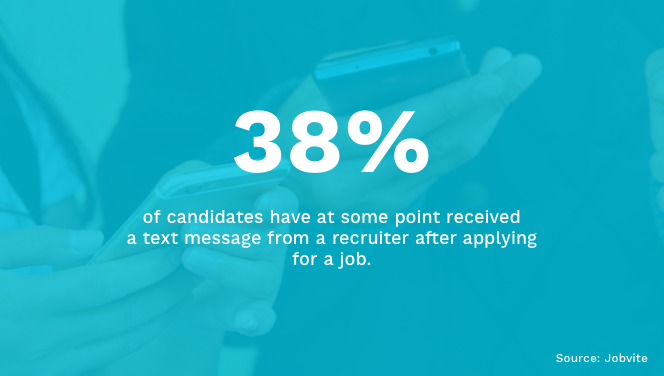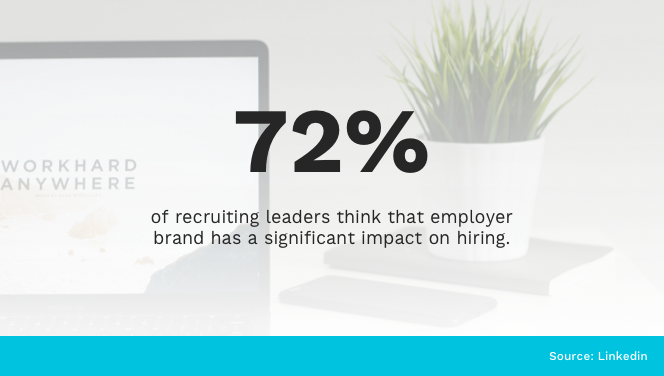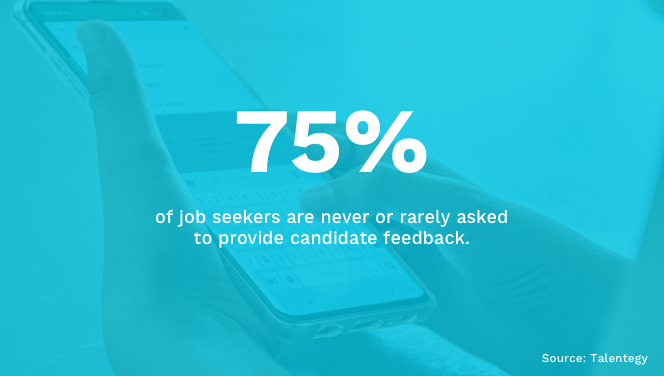When you master the art of communicating effectively with candidates, you reap tons of benefits. From providing a higher-quality recruitment experience to speeding up your hiring process and maintaining a stellar employer brand – there are plenty of perks to refining how you interact with job applicants.
This prompts us to ask: ‘How do you improve candidate communications throughout the recruitment process?’
If you’re curious to know the answer, continue reading as we discuss that very question!
What’s in?
- Map out your main touchpoints
- Share the timeline
- Provide status updates
- Be ready to answer questions – promptly
- Personalize your messaging
- Utilize text messaging
- Rethink your rejection letters
- Be consistent
- Ask for feedback
Like what you see?
Don’t miss out. Subscribe to our quarterly digest to get the latest TA and TM resources delivered right to your inbox.
1. Map out your main touchpoints
First thing first, you need to fully grasp when and how you’ll contact applicants, which means establishing a list of touchpoints. This will vary from organization to organization, but it might resemble something like the pipeline below:
- The pre-application phase. You should reply to job seekers (either via email or text) when someone subscribes to receive careers-related alerts. Similarly, you should also respond to prospects when they ask whether you’re hiring. Be sure to thank them for their interest and direct them to your latest job vacancies. You should also explain how they can receive updates about any openings you post in the future.
- During the application. At the very least, you should ping over an email or text message to candidates as soon as they send an application. A week later, it’s worth following up to reassure them their application is being processed.
- A change in status. You’ll also want to contact the candidate whenever the status of their application changes. For example, if they pass the pre-screening phase and you’re ready to offer an interview.
- Interviews. Needless to say, when it gets to the point where you’re scheduling interviews with candidates, you’ll need a robust two-way communication system. Yes, you can write and send all your messages manually but if you’re running a more extensive recruitment drive, you may find automated scheduling emails useful for better managing your communications.
- The post-application phase. Last but not least, always tell candidates once you’ve made a decision – whether that be a job offer or a rejection. Closing the loop is key to maintaining a good employer brand and staying on good terms with candidates.
Once you’ve mapped out all your touchpoints, you’ll be in a better position to start planning, analyzing, and improving each communication stage. Further down the road, you’ll be able to make necessary tweaks to ensure you have the best possible candidate communication strategy in place.

Candidate communication is a key component of candidate experience but also a way to make your recruitment process more efficient.
2. Share the timeline
While you’re mapping out these touchpoints, assign realistic time frames for when you’ll contact applicants. Then, once you have a timeline in mind, communicate that to your candidates. You should clarify exactly how many stages your recruitment process has, what they entail, how long each phase takes, and what step they’re currently at.
There’s a good chance your timeline will vary depending on the role you’re hiring for. So, be sure to reevaluate this each time you launch a new recruitment campaign.
Then, if there are delays in the timeline you’ve set, let candidates know. Which leads us nicely onto our next point…
3. Provide status updates
It’s imperative candidates stay informed about what’s happening with their application. They’ll appreciate being in the know. For example, if your recruitment efforts are impacted by COVID-19, keep them informed about how the pandemic affected the process, how you’re responding to it, and, most importantly, how this impacts your applicants.
You may also find your recruitment process is subject to delays that force you to adjust your timeline. Perhaps you received more applications than you expected? Or maybe one of your interviewers went off sick? Whatever the issue, be transparent about the delays and provide candidates with an updated, more realistic date as to when they’ll hear back from you. This is crucial for maintaining their interest in your job vacancies.

1 in 4 candidates prefer phone calls. You can also ask your shortlisted candidates what their preferred methods are to boost the candidate experience.
4. Be ready to answer questions – promptly
Your talent acquisition team should be ready to answer questions from the get-go. There’s a good chance candidates will inquire about the role or the application process, so be ready and willing to provide prompt responses.
Give prospects a point of contact in your job ads, or have a chatbot on your careers site where applicants can ask their questions. If there are any frequently asked questions your support team receives all the time, create an FAQ page which applicants can refer to.
5. Personalize your messaging
Customize the messages you send applicants based on where they’re at in the recruitment process and their engagement with previous messages. Avoid anonymous mass mailings – this doesn’t look great for your employer brand. Plus, you’re less likely to provide applicants with the specific info they’re after.
In short: Wherever possible, tailor communications to meet the exact needs of the recipient.
How AI & recruitment technology is changing recruiting experience
Find out how tech has helped other companies grow by enhancing both the recruiters’ and candidates’ experience!
6. Utilize text messaging
Texts get way more opens than emails. In fact, studies show that SMS open rates can be as high as 98%! Many find texting quicker and more accessible than email – which makes engaging with prospects much more manageable.
A great example of how recruiters could use text messaging is before an interview. For instance, you could send a ‘reminder’ message recapping the details of the meeting. Like the location or the information about the video interview software you’re using, who they’re interviewing with, anything they need to prepare, etc. This works wonders for ensuring candidates have everything they need to prepare and putting pre-interview nerves at bay – win-win!

Text messaging is gaining popularity in recruitment, among candidates and recruiters alike.
7. Rethink your rejection letters
If you’re rejecting a candidate further down the recruitment process, especially after a couple of interviews, provide some feedback. Why weren’t they successful on this occasion? Let them know in your rejection letter. If you don’t have the time to write long emails brimming with in-depth advice, at least give them a few bullet points. Then, at the end of the message, let them know that you’re happy to provide more info if they call.
You don’t need us to tell you that rejection letters need to be handled with sensitivity. It’s not a pleasant task, but it needs to be done! There’s nothing wrong with sending a generic ‘it’s with regret’ letter for the first section of your rejection email. Still, you should always address the candidate by name, and as we’ve just said, offer some kind of feedback as to why and how you came to your decision.
You might be wondering whether constructive criticism will be well-received. If so, put that concern to bed. Job seekers want to find a job. Period. The more info they can get about what they’ve done well, and more importantly, what they need to improve on in their applications and interviews, the better. You’re providing a golden opportunity to enhance their next application, so there’s a good chance they’ll be thankful for the advice!
Plus, if the candidate’s still of interest to your company – even if they don’t quite suit the role that’s currently on offer, invite them to apply again. Explain why they impressed you and your hiring team, this will ensure that your invitation to reapply at a later date appears genuine.
8. Be consistent
Consistency is critical, not only with what you’re saying to applicants but also how you go about saying it. As you’ve probably guessed, we’re talking about establishing a tone of voice that’s unique to your employer brand.
So take some time thinking about the kind of language and tone you’ll use while communicating with your candidates. Getting this right is an effortless way of building rapport with applicants and developing a robust employer brand candidates associate with your organization.
When it comes to establishing a voice for your employer brand, here’s some advice:
- Keep it short and sweet. Job seekers are busy people – they spend hours applying and following up on jobs, so respect their time by communicating what they need to hear quickly and concisely.
- Understand how others see your brand. As you formulate the tone of voice for your employer brand, you’ll want to consider how people already perceive you. There’s a good chance your current employees use and share their experiences working with your brand on platforms like Facebook, LinkedIn, Twitter, Glassdoor, etc. Candidates put great stock on what previous and current employees have to say. In fact, 70% of people look at these kinds of reviews before making a career decision. So, what kind of comments are published about your brand? This is a valuable source of data for helping you settle on the best possible messaging. Capitalize on whatever positive things are being said about you. Similarly, do your best to overcome any hurdles that negative comments may have put in the way of others applying to work with your company.
- Keep it professional. Even if your workplace culture is a relaxed one, you’ll still want to keep things professional. This helps to ensure boundaries are set and adhered to.
- Treat candidates like customers. More and more job seekers treat job searches like online shopping. So, it’s increasingly important that just like you do with customers, that you provide candidates a positive, consistent, and engaging journey. So keep this at the forefront of your mind as you start to craft a distinct tone of voice for your brand.

That’s why you also need to be consistent with your employer brand in your candidate communication.
9. Ask for feedback
The most effective way to improve your candidate communication strategy is to ask for feedback both throughout the process and at the end (from both successful and rejected candidates). Not only does this show you care about the experience you provide candidates, but it also keeps candidates engaged in your recruitment process. Once you collect some feedback, you’ll have a more accurate insight into how you could improve your recruitment process.
After all, just like your whole hiring plan, any effective communication strategy leaves room for continual improvement. So, go ahead and use a tool like Google Forms or Survey Monkey to create a quick and anonymous survey that enables candidates to be frank about their experience with your brand.
Ask pointed questions that will provide the data you need to enhance your recruitment process. Then once you’ve gathered this info, compile it into a report and circulate it around your team. That way, you can work together using the results of the survey to fuel whatever improvements you put in place.
Top Tip: As we’ve already said, job seekers are busy people. They don’t have time to fill out reams of paperwork. So, limit your survey to seven questions at most.

68.5% of candidates are happy to provide feedback to their potential employer, so why not ask for it and use it to improve your recruitment process?
Are you ready to up your candidate communication efforts?
Having read all of the above, it’s clear that how you communicate with candidates during the recruitment phase reflects on you as an employer. That’s why ensuring your communications are relevant, useful, timely, and, most importantly, consistent with your brand is imperative. And remember, don’t keep candidates in the dark…or even worse, ghost them – keep them in the loop every step of the way. This is key to keeping them engaged and ensuring you provide a pleasant applicant experience. If you follow all this advice, you stand a pretty good chance of creating and executing a high-quality candidate communication strategy. Good luck!
How AI & recruitment technology is changing recruiting experience
Find out how tech has helped other companies grow by enhancing both the recruiters’ and candidates’ experience!


